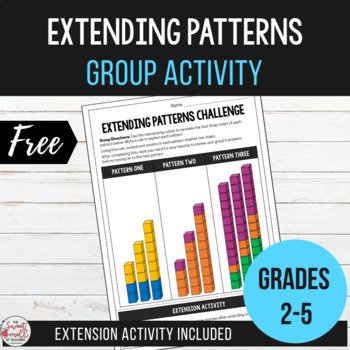- PDF
Description
Extending Patterns Challenge
Pattern activities can be used to teach students how to evaluate, generalize and express functional relationships as well as develop their algebraic reasoning skills. This activity involves using objects to explore mathematical problems. Learning is supported through concrete manipulatives and an activity sheet.
Activity Instructions
Students should be divided into groups and provided with the activity sheet and interlocking cubes. The activity sheet delivers the necessary instructions to complete each task and can be used as a visual guide as students extend their patterns.
To differentiate, activities will become progressively harder. Advanced students will progress through to the extension activity (can be completed independently or in their small groups), whilst those unable to understand the essentials can focus on the basic concepts involved with identifying pattern rules. The replication and extension of the patterns will be need to be completed using concrete manipulatives.
The groups will move back into a whole class setting for discussion. Each group will verbalize their understanding of each pattern's underlying rule and explain the strategies they used to identify this rule.
This product covers the following material:
- Growing/increasing patterns
- Shrinking/decreasing patterns
Looking for more resources involving patterns? You may also be interested in:
• Growing & Shrinking Number Patterns - Christmas Edition
• Growing & Shrinking Number Patterns - Challenge Sheets
• Growing & Shrinking Number Patterns - True or False Challenge Cards
• Identifying Pattern Rules in Growing and Shrinking Number Patterns - Worksheets
★★ Don't forget to follow my store for updates on freebies, sales, and new products!
Follow The Sweet Smell of Teaching on TpT.
If you like this product, you may also be interested in these resources:
Operations & Algebraic Thinking
• Multiplication Games - Memory Cards
• Balance the Equations - True or False Equivalence Challenge Cards
• Balancing Equations - Equivalent Number Sentence Challenge Sheets
• Balance the Equation - Equivalent Number Sentence Jigsaw Activity
Number & Operations in Base Ten
• Rounding Numbers - Task Card Activities
• Addition & Subtraction with Regrouping Activities
• Addition & Subtraction with Regrouping Activities - Back to School Edition
Number & Operations - Fractions
• Comparing Fractions, Decimals & Percents - Comparison Cards & Worksheets
• Fraction and Decimal Games - Memory Cards
Measurement & Data
• Metric Measurement Conversions - True or False Challenge Cards


